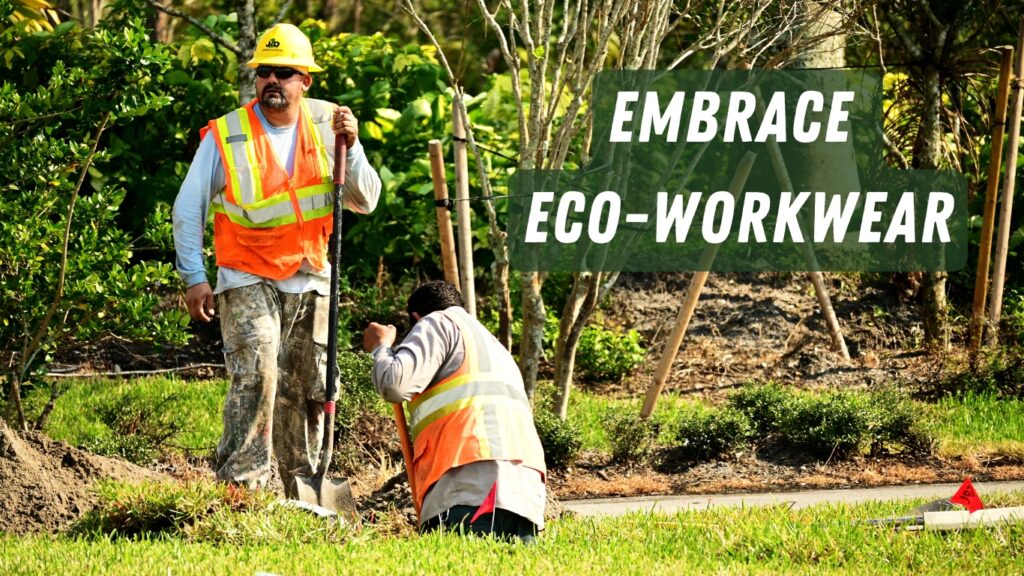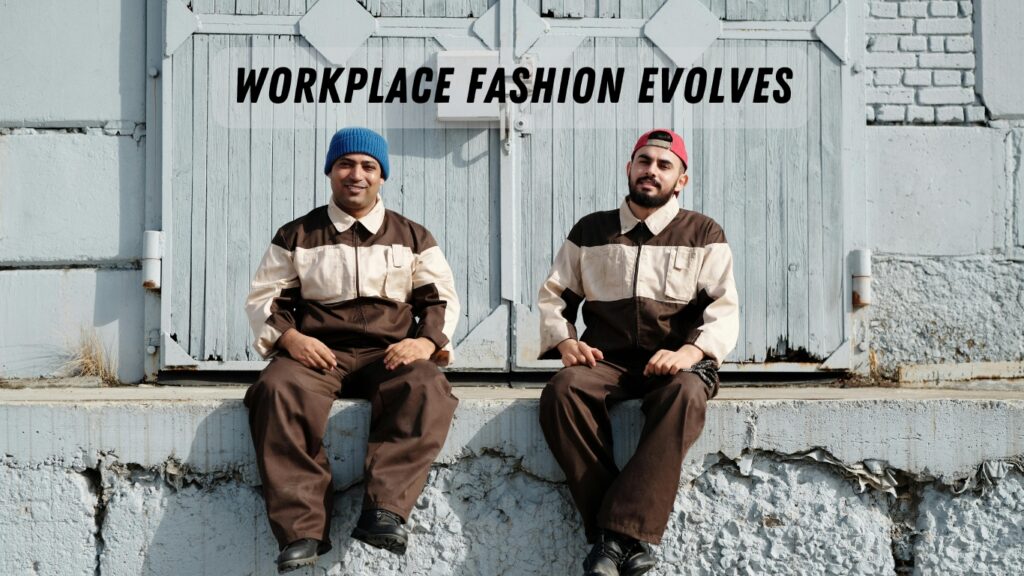
The future of workwear is being shaped by technological advancements, evolving workplace environments, and a rising demand for sustainability. In 2025, functional fashion will be at the core of workwear innovation, integrating performance fabrics, smart textiles, and ergonomic designs.
Businesses are prioritizing safety, durability, and comfort while ensuring compliance with workplace regulations and employee preferences. This article explores the key workwear trends shaping global industries, providing insights for buyers looking to stay ahead in the market.
1. The Shift Toward Hybrid Workwear: Blending Office and Casual Attire
With remote and hybrid work models becoming the standard, the need for multi-functional workwear that transitions between professional and casual settings is rising. Employees no longer want rigid business suits; they demand versatility and comfort.
Why Hybrid Workwear is the Future
- Casual dress codes in corporate environments are allowing greater flexibility in attire.
- Ergonomic tailoring improves mobility, breathability, and extended wearability.
- Stretchable and wrinkle-resistant fabrics help professionals maintain a polished look while working remotely or in-office.
Key Trends in Hybrid Workwear for 2025
- Performance dress shirts featuring moisture-wicking, anti-wrinkle, and odor-resistant textiles¹.
- Adaptive blazers and work trousers with temperature-regulating technology², allowing wearers to stay comfortable in different climates.
- Hybrid footwear that combines sneaker-like comfort with formal aesthetics, suitable for both office and remote work.
With brands like Everlane, Theory, and Hugo Boss developing performance-driven office attire, the future of professional wear will emphasize flexibility, durability, and sustainability.
2. Smart Textiles: The Rise of Tech-Enabled Workwear
Workwear innovation is being driven by smart textiles, integrating wearable technology that enhances safety, performance, and efficiency. These high-tech garments are being used across industries, from corporate settings to construction and industrial environments.
Why Smart Textiles Are Transforming Workwear
- Biometric sensors embedded in work clothing monitor heart rate, fatigue levels, and posture, reducing workplace injuries.
- Temperature-adaptive fabrics allow workers to stay comfortable in extreme climates, minimizing heat stress and cold-related illnesses.
- Anti-bacterial and self-cleaning materials prevent contamination and increase garment longevity.
Key Smart Textile Innovations in 2025
- Wearable exoskeletons for factory workers, reducing physical strain and injury risks in labor-intensive jobs.
- AI-powered uniforms that track ergonomic movements, ensuring correct posture to prevent work-related musculoskeletal issues ³.
- Energy-harvesting garments, allowing workers to generate power from body movements, which can charge small devices.
Leading brands such as Carhartt, Helly Hansen, and Wearable X are investing in smart workwear, creating solutions that enhance worker safety and productivity.
3. Sustainability in Workwear: The Demand for Eco-Friendly Uniforms
Sustainability is becoming a major consideration for businesses investing in work uniforms and protective apparel. Companies are seeking recyclable, biodegradable, and ethically sourced materials to meet growing environmental regulations and consumer expectations.
Why Sustainable Workwear is Gaining Popularity
- Regulatory policies, such as the EU Extended Producer Responsibility (EPR) law⁴, are holding businesses accountable for textile waste.
- Consumers and businesses prefer workwear made with organic cotton, recycled polyester, and cruelty-free fabrics.
Eco-friendly production methods reduce water and chemical usage, minimizing fashion’s environmental footprint.

Key Trends in Sustainable Workwear
- Textile-to-textile recycling, enabling closed-loop manufacturing that extends the lifespan of materials ⁵.
- Waterless dyeing techniques, eliminating toxic chemicals used in traditional workwear production.
- Long-lasting, low-maintenance fabrics, reducing the need for frequent replacements and lowering costs.
With companies like Patagonia Workwear, Dickies, and Red Kap leading sustainable uniform production, the future of eco-friendly work apparel is set to expand significantly.
4. Industrial Workwear: Enhancing Durability and Safety
For industries such as construction, manufacturing, and oil & gas, durability and safety are non-negotiable in workwear. The future of industrial apparel is centered on high-performance materials that offer protection without compromising mobility.
Why Durability is Key in Industrial Workwear
- Workplace safety regulations are becoming stricter, requiring clothing that meets fire resistance, cut protection, and chemical resistance standards.
- Comfort and breathability are crucial for long working hours in hazardous environments.
- High-visibility fabrics with reflective detailing improve safety in low-light conditions.
Key Advancements in Industrial Workwear
- Fire-resistant and arc-rated clothing ensuring worker protection in high-risk industries.
- Protective gloves and outerwear with cut-resistant fibers, safeguarding workers handling sharp tools ⁶.
- LED-embedded safety gear, enhancing visibility for nighttime and underground workers.
With manufacturers such as 3M, DuPont, and Blåkläder investing in innovative safety solutions, the industrial workwear sector will continue to advance in performance and compliance.
5. Custom-Fit and Adaptive Workwear: The Personalization Trend
Customization in workwear is expanding, ensuring a better fit for diverse body types, gender inclusivity, and unique job roles. Businesses are now looking for tailored uniforms and adjustable designs to improve comfort and efficiency.
Why Custom-Fit Workwear is the Future
- Ill-fitting workwear reduces productivity and comfort, impacting worker performance.
- Women and plus-size professionals require better-fitted uniforms to accommodate different body shapes and movement patterns.
- Adaptive clothing is enabling people with disabilities to wear functional work attire with ease.
Key Trends in Custom Workwear
- 3D body scanning technology, allowing businesses to order perfectly tailored uniforms for employees. Check out this video of making a suit by a 3D body scanner –
- Adjustable sizing features, enabling garments to expand or tighten based on user preference ⁷.
- Gender-neutral workwear collections, moving away from traditional male-dominated uniform designs.
With companies like Uniqlo Workwear and Snickers Workwear focusing on tailored workwear solutions, the demand for inclusive and adaptive professional attire is expected to rise significantly.
6. High-Performance Outdoor Workwear: Weather-Resistant and Tactical Gear
Workers in construction, logistics, agriculture, and emergency response require workwear that protects against extreme weather conditions while maintaining flexibility and durability. The future of outdoor workwear will integrate climate-adaptive materials, reinforced insulation, and tactical functionality.
Why High-Performance Outdoor Workwear is Expanding
- Climate change is increasing exposure to extreme temperatures, requiring weather-adaptive gear.
- Workers in high-risk outdoor environments need protective apparel that can withstand harsh conditions.
- Lightweight yet durable fabrics allow workers to maintain mobility without sacrificing safety.
Key Advancements in Outdoor Workwear
- Temperature-regulating jackets utilizing phase-change materials¹ that adjust insulation based on body heat.
- Waterproof and wind-resistant workwear with breathable membranes, preventing overheating while offering protection.
- Multi-layered tactical apparel designed for military, law enforcement, and emergency responders, integrating reinforced knee and elbow panels.
With brands like Carhartt, Columbia Workwear, and The North Face leading the way in performance outdoor clothing, workwear in extreme environments is becoming safer and more adaptable than ever.
7. Medical and Healthcare Workwear: Antimicrobial and Ergonomic Designs
The healthcare industry requires workwear that offers comfort, protection, and hygiene. The future of medical uniforms and PPE is shifting toward sustainable, antimicrobial, and ergonomic designs.
Why Medical Workwear is Evolving
- Increased demand for infection control is driving the adoption of self-cleaning fabrics.
- Healthcare workers need flexible and breathable attire to withstand long shifts.
Sustainability concerns are pushing the industry to reduce disposable PPE waste.

Key Innovations in Medical Workwear
- Antimicrobial scrubs treated with silver-ion technology², reducing bacterial growth.
- Self-repairing lab coats embedded with nano-coatings³, minimizing damage from spills.
- Sustainable PPE and biodegradable gloves, reducing medical waste while maintaining protection standards.
With major healthcare brands like Figs, Cherokee, and Jaanuu developing high-performance medical attire, the industry is shifting toward comfort, safety, and environmental responsibility.
8. Corporate and Luxury Workwear: The Evolution of Professional Attire
The definition of corporate fashion is evolving as employees seek sophisticated yet comfortable office wear. Luxury brands are entering the workwear space, offering premium, tailored business attire that meets modern demands.
Why Luxury and Corporate Workwear Are Growing
- The decline of traditional suits has paved the way for flexible, minimalist office fashion.
- Luxury brands are launching workwear collections, merging high-end fashion with professional aesthetics.
- Executives and high-ranking professionals prefer custom-fitted, functional clothing that reflects their brand image.
Key Trends in Corporate Workwear for 2025
- Wrinkle-free wool and cotton blends offering natural stretch and breathability⁴.
- Minimalist power suits combining tailored silhouettes with stretch fabrics for all-day wear.
- Sustainable luxury workwear, reducing carbon footprints while maintaining premium aesthetics.
With brands like Hugo Boss, Ralph Lauren, and Theory revolutionizing high-end business fashion, corporate workwear is shifting toward versatility, performance, and sustainability.
9. Gender-Neutral Workwear: Breaking Traditional Norms
The workwear industry is embracing gender inclusivity, moving away from traditional male- and female-specific uniforms. Companies are developing unisex clothing that caters to diverse body shapes and gender identities.
Why Gender-Neutral Workwear is Expanding
- Many workers prefer a non-gendered fit, ensuring equal comfort and accessibility.
- Traditional workwear designs often exclude non-binary individuals, limiting their professional attire choices.
- Inclusive workwear promotes workplace diversity, aligning with corporate sustainability goals.
Key Trends in Gender-Neutral Workwear
- Oversized yet tailored designs, focusing on versatile cuts and functional silhouettes.
- Neutral color palettes, featuring **earthy, monochrome, and minimalist tones⁵](https://www.businessoffashion.com/articles/retail/gender-neutral-fashion-trends/).
- Adjustable fit technology, allowing wearers to customize sizing based on comfort and preference.
With companies like Zara, H&M, and Uniqlo expanding unisex collections, gender-neutral workwear is becoming a mainstream category in global retail.
10. Workwear Rentals and Subscription Models: The Future of Workplace Fashion
With sustainability at the forefront, companies are adopting workwear rental and leasing models to reduce costs and minimize textile waste. Businesses are now offering subscription-based uniforms, allowing employees to rotate workwear based on their needs.

Why Workwear Rentals Are Gaining Popularity
- Companies can save money on uniform costs while ensuring employees always have high-quality apparel.
- Sustainable rental models reduce fabric waste, contributing to a circular fashion economy.
- Workers benefit from customizable uniform selections, tailored to different job roles and conditions.
Key Trends in Workwear Rental Services
- Corporate leasing programs, providing employees with recyclable, high-performance uniforms⁶.
- On-demand workwear solutions, allowing companies to replace worn-out uniforms instantly.
- AI-driven sizing and subscription platforms, improving fit accuracy and reducing unnecessary returns.
With companies like Cintas, Rent the Runway, and The Uniform Edit leading the workwear rental market, businesses are adopting cost-effective and sustainable apparel solutions.
RYZEAL’s Final Thoughts
As workwear continues to evolve, businesses must focus on functionality, sustainability, and adaptability to meet the needs of modern professionals. From smart textiles and ergonomic designs to gender-neutral and rental-based workwear models, the future of workplace fashion is centered on comfort, technology, and inclusivity.
At RYZEAL SOURCING, we understand the challenges that buyers, manufacturers, and retailers face in keeping up with emerging apparel trends. By partnering with sustainable and high-performance workwear manufacturers, we help businesses source customized, durable, and forward-thinking uniforms that align with market demands and regulatory standards.
The future of workwear is not just about clothing—it’s about ensuring that employees feel safe, comfortable, and empowered in their professional environments. Companies that invest in quality, innovative, and sustainable workwear will set themselves apart in the competitive global market.
References
- Textile World – Next-Gen Textiles for Activewear and Workwear – https://www.textileworld.com/textile-world/nonwovens-technical-textiles/2023/04/next-gen-textiles-for-activewear/
- Forbes – The Rise of Hybrid Workwear and Performance Business Attire – https://www.forbes.com/sites/forbesbusinesscouncil/2023/06/19/the-rise-of-hybrid-workwear/
- ScienceDirect – Smart Textiles and AI-Powered Workwear for Safety Applications – https://www.sciencedirect.com/science/article/pii/S0264127522005148
- European Commission – EU Extended Producer Responsibility (EPR) and Textile Waste Regulations – https://ec.europa.eu/environment/topics/circular-economy/textiles_en
- Common Objective – What is a Circular Textile Industry? – https://www.commonobjective.co/article/what-is-a-circular-textile-industry
- Forbes Business Council – How Bioengineered Fabrics are Reshaping the Fashion Industry – https://www.forbes.com/sites/forbesbusinesscouncil/2023/01/18/how-bioengineered-fabrics-are-reshaping-the-fashion-industry/?sh=19b9b4c51b26
- OSHA – Workplace Safety Gear and Protective Clothing Regulations – https://www.osha.gov/workplace-safety-gear-standards
- Business of Fashion – Gender-Neutral Fashion Trends in Workwear – https://www.businessoffashion.com/articles/retail/gender-neutral-fashion-trends/
- Vogue Business – The Rise of Workwear Rentals and Corporate Uniform Leasing – https://www.voguebusiness.com/sustainability/the-rise-of-workwear-rentals
- Wired – Custom-Fit Workwear and 3D Tailoring Innovations – https://www.wired.com/story/custom-fit-workwear-advancements/
